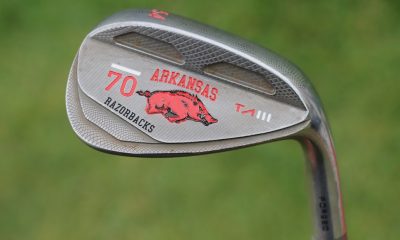Instruction
Short Game University: How to hit wedges 301

In golf, there is nothing harder than judging a flop shot over a bunker to a tight pin out of long grass. Why? Because there are so many variables to account for — in addition to what you can and cannot do with a wedge. In fact, up until very recently in the world of wedge design, we were limited to only increasing the landing angle to stop the ball, because relying on spin from this lie and this close to the green was next to impossible.
Now with the advent of things like raw faces, different CG locations, new groove design, and micro-ribs between the grooves, we can now spin the ball out of lies that we never could have done so before. This is not to say that you can now zip the ball back from these types of lies, but we are seeing spin rates that have skyrocketed, and this allows us to not open the face as much as we needed to do before in order to stop the ball.

Before we get into the shot around the green itself, let’s talk a bit about wedge design. For that, I called a great friend of mine, Greg Cesario, TaylorMade’s Staff Manager to help us understand a bit more about wedges. Greg was a former PGA Tour Player and had a big hand in designing the new Milled Grind 3 Wedges.
Cesario said: “Wedge technology centers on two key areas- the first is optimizing its overall launch/spin (just like drivers) on all shots and the second is optimum ground interaction through the geometry of the sole (bounce, sole width, and sole shape).”
“Two key things impact spin: Groove design and face texture. Spin is the secondary effect of friction. This friction essentially helps the ball stick to the face a little longer and reduces slippage. We define slippage as how much the ball slides up the face at impact. That happens more when it’s wet outside during those early morning tee times, out of thicker lies, or after a bit of weather hits. Our Raised Micro-Ribs increase friction and reduce slippage on short partial shots around the round – that’s particularly true in wet conditions.”
“We’ve been experimenting with ways to find optimal CG (center of gravity) placement and how new geometries can influence that. We know that CG locations can influence launch, trajectory and spin. Everyone is chasing the ability to produce lower launching and higher spinning wedge shots to help players increase precision distance control. In that space, moving CG just a few millimeters can have big results. Beyond that, we’re continuing to advance our spin and friction capabilities – aiming to reduce the decay of spin from dry to fluffy, or wet conditions.”
Basically, what Greg is saying is that without improvements in design, we would never be able to spin the ball like we would normally when it’s dry and the lie is perfect. So, with this new design in a wedge like the Milled Grind 3 (and others!), how can we make sure we have the optimal opportunity to hit these faster-stopping pitch shots?
- Make sure the face is clean and dry
- Open the blade slightly, but not too much
- Set the wrists quicker on the backswing to increase the AoA
- Keep the rear shoulder moving through impact to keep the arms going
Make sure the face is clean and dry
If your thought is to use spin to stop the ball quicker under any situation, then you must give the club a chance to do its job. When the grooves are full of dirt and grass and the remaining exposed face is wet, then you are basically eliminating any opportunity to create spin. In fact, if you decide to hit the shot under these conditions, you might as well hit a flop shot as this would be the only opportunity to create a successful outcome. Don’t put yourself behind the eight-ball automatically, keep your club in a clean and dry condition so you have the best chance to do what you are capable of doing.
Open the blade slightly, but not too much
Without going into too much extra detail, spinloft is the difference between your angle of attack and your dynamic loft. And this difference is one of the main areas where you can maximize your spin output.

Too little or too much spinloft and you will not be able to get the maximum spin out of the shot at hand. With wedges, people equate an open clubface to spinning the ball, and this can be a problem due to excessive spinloft. Whenever you have too much dynamic loft, the ball will slide up the face (reduced friction equals reduced spin) and the ball will float out higher than expected and roll out upon landing.
My thought around the green is to open the face slightly, but not all the way, in efforts to reduce the probability of having too much spinloft during impact. Don’t forget under this scenario we are relying on additional spin to stop the ball. If you are using increased landing angle to stop the ball, then you would obviously not worry about increasing spinloft! Make sure you have these clear in your mind before you decide how much to open the blade.
Opened slightly

Opened too much

One final note: Please make sure you understand what bounce option you need for the type of conditions you normally play. Your professional can help you but I would say that more bounce is better than less bounce for the average player. You can find the bounce listed on the wedge itself. It will range between 4-14, with the mid-range bounce being around 10 degrees.
Set the wrists quicker on the backswing to increase the angle of attack
As we know, when debris gets in between the clubface and the ball (such as dirt/grass), you will have two problems. One, you will not be able to control the ball as much. Secondly, you will not be able to spin the ball as much due to the loss of friction.
So, what is the key to counteract this problem? Increasing the angle of attack by setting the wrists quicker on the backswing. Making your downswing look more like a V rather than a U allows less junk to get between the club and the ball. We are not using the bounce on this type of shot, we are using the leading edge to slice through the rough en route to the ball. Coming in too shallow is a huge problem with this shot, because you will tend to hit it high on the face reducing control.
Use your increased AoA on all of your crappy lies, and you will have a much better chance to get up and down more often!
Keep the rear shoulder moving through impact to keep the arms going
The final piece of the puzzle through the ball is speed through the pivot. You cannot hit shots around the green out of tall grass without keeping the club moving and having speed. A reduction of speed is obvious as the club enters into the tall grass, but you don’t want to exacerbate this problem by cutting off your pivot and letting the arms do all the work.
Sure, there are times when you want to cut off the body rotation through the ball, but not on the shot I am discussing here. When we are using spin, you must have speed to generate the spin itself. So, what is the key to maintaining your speed? Keeping the rear shoulder rotating long into the forward swing. If you do this, you will find that your arms, hands, and club will be pulled through the impact zone. If your pivot stalls, then your speed will decrease and your shots will suffer.
Hopefully, by now you understand how to create better shots around the green using the new wedge technology to create more spin with lies that we had no chance to do so before. Remembering these simple tips — coupled with your clean and dry wedge — will give you the best opportunity to be Tiger-like around the greens!
- LIKE88
- LEGIT21
- WOW4
- LOL0
- IDHT0
- FLOP2
- OB3
- SHANK9
Instruction
Clement: Laid-off or perfect fade? Across-the-line or perfect draw?

Some call the image on the left laid off, but if you are hitting a fade, this could be a perfect backswing for it! Same for across the line for a draw! Stop racking your brain with perceived mistakes and simply match backswing to shot shape!
- LIKE0
- LEGIT0
- WOW0
- LOL0
- IDHT0
- FLOP0
- OB0
- SHANK1
Instruction
The Wedge Guy: The easiest-to-learn golf basic

My golf learning began with this simple fact – if you don’t have a fundamentally sound hold on the golf club, it is practically impossible for your body to execute a fundamentally sound golf swing. I’m still a big believer that the golf swing is much easier to execute if you begin with the proper hold on the club.
As you might imagine, I come into contact with hundreds of golfers of all skill levels. And it is very rare to see a good player with a bad hold on the golf club. There are some exceptions, for sure, but they are very few and very far between, and they typically have beat so many balls with their poor grip that they’ve found a way to work around it.
The reality of biophysics is that the body moves only in certain ways – and the particulars of the way you hold the golf club can totally prevent a sound swing motion that allows the club to release properly through the impact zone. The wonderful thing is that anyone can learn how to put a fundamentally sound hold on the golf club, and you can practice it anywhere your hands are not otherwise engaged, like watching TV or just sitting and relaxing.
Whether you prefer an overlap, interlock or full-finger (not baseball!) grip on the club, the same fundamentals apply. Here are the major grip faults I see most often, in the order of the frequency:
Mis-aligned hands
By this I mean that the palms of the two hands are not parallel to each other. Too many golfers have a weak left hand and strong right, or vice versa. The easiest way to learn how to hold the club with your palms aligned properly is to grip a plain wooden ruler or yardstick. It forces the hands to align properly and shows you how that feels. If you grip and re-grip a yardstick several times, then grip a club, you’ll see that the learning curve is almost immediate.
The position of the grip in the upper/left hand
I also observe many golfers who have the butt of the grip too far into the heel pad of the upper hand (the left hand for right-handed players). It’s amazing how much easier it is to release the club through the ball if even 1/4-1/2″ of the butt is beyond the left heel pad. Try this yourself to see what I mean. Swing the club freely with just your left hand and notice the difference in its release from when you hold it at the end of the grip, versus gripping down even a half inch.
To help you really understand how this works, go to the range and hit shots with your five-iron gripped down a full inch to make the club the same length as your seven-iron. You will probably see an amazing shot shape difference, and likely not see as much distance loss as you would expect.
Too much lower (right) hand on the club
It seems like almost all golfers of 8-10 handicap or higher have the club too far into the palm of the lower hand, because that feels “good” if you are trying to control the path of the clubhead to the ball. But the golf swing is not an effort to hit at the ball – it is a swing of the club. The proper hold on the club has the grip underneath the pad at the base of the fingers. This will likely feel “weak” to you — like you cannot control the club like that. EXACTLY. You should not be trying to control the club with your lower/master hand.
Gripping too tightly
Nearly all golfers hold the club too tightly, which tenses up the forearms and prevents a proper release of the club through impact. In order for the club to move back and through properly, you must feel that the club is controlled by the last three fingers of the upper hand, and the middle two fingers of the lower hand. If you engage your thumbs and forefingers in “holding” the club, the result will almost always be a grip that is too tight. Try this for yourself. Hold the club in your upper hand only, and squeeze firmly with just the last three fingers, with the forefinger and thumb off the club entirely. You have good control, but your forearms are not tense. Then begin to squeeze down with your thumb and forefinger and observe the tensing of the entire forearm. This is the way we are made, so the key to preventing tenseness in the arms is to hold the club very lightly with the “pinchers” — the thumbs and forefingers.
So, those are what I believe are the four fundamentals of a good grip. Anyone can learn them in their home or office very quickly. There is no easier way to improve your ball striking consistency and add distance than giving more attention to the way you hold the golf club.
More from the Wedge Guy
- The Wedge Guy: Golf mastery begins with your wedge game
- The Wedge Guy: Why golf is 20 times harder than brain surgery
- The Wedge Guy: Musings on the golf ball rollback
- LIKE88
- LEGIT15
- WOW6
- LOL1
- IDHT0
- FLOP4
- OB1
- SHANK9
Instruction
Clement: Stop ripping off your swing with this drill!

Not the dreaded headcover under the armpit drill! As if your body is defective and can’t function by itself! Have you seen how incredible the human machine is with all the incredible feats of agility all kinds of athletes are accomplishing? You think your body is so defective (the good Lord is laughing his head off at you) that it needs a headcover tucked under the armpit so you can swing like T-Rex?
- LIKE0
- LEGIT3
- WOW2
- LOL0
- IDHT0
- FLOP0
- OB0
- SHANK2
-

 19th Hole3 weeks ago
19th Hole3 weeks agoLET pro gives detailed financial breakdown of first week on tour…and the net result may shock you
-

 19th Hole1 week ago
19th Hole1 week agoReport: LIV star turns down PGA Championship invite due to ‘personal commitments’
-

 19th Hole2 weeks ago
19th Hole2 weeks agoGary Player claims this is what ‘completely ruined’ Tiger Woods’ career
-

 Equipment1 week ago
Equipment1 week agoDetails on Justin Thomas’ driver switch at the Wells Fargo Championship
-

 Whats in the Bag2 weeks ago
Whats in the Bag2 weeks agoTeam McIlowry (Rory McIlroy, Shane Lowry) winning WITBs: 2024 Zurich Classic
-

 Whats in the Bag1 week ago
Whats in the Bag1 week agoKeegan Bradley WITB 2024 (May)
-

 Equipment2 weeks ago
Equipment2 weeks agoGolf fans left surprised by LIV’s choice of course for its 2024 individual championship event
-

 Whats in the Bag3 days ago
Whats in the Bag3 days agoRory McIlroy’s winning WITB: 2024 Wells Fargo Championship






























